Dive into the fascinating realm of tall indoor plants, where vertical growth knows no bounds! Are you seeking to infuse your living space with a breath of fresh air, incorporate natural elegance, or simply establish a lush, green haven within your home? Look no further.
In this article, we’ll delve into the world of towering greenery as we unveil the top tall indoor plant varieties that will take your home decor to the next level. From the beloved Fiddle Leaf Fig to succulents like the African Milk Tree, there’s one for any style and aesthetics.
So, whether you’re a seasoned gardener or visiting the green side for the first time, let’s find together the first or next plant you’ll be adding to your space.
Table of Contents
1. Fiddle Leaf Fig (Ficus Lyrata)

The Fiddle leaf fig (Ficus lyrata) is a popular choice among tall indoor plants, known for its large, violin-shaped leaves and architectural presence. This West African native can grow up to 10 feet tall indoors and thrives in bright, indirect light.
Ensure even growth by rotating the plant every few weeks and maintain proper watering by allowing the top few inches of soil to dry out between waterings. Use a well-draining potting mix and feed with a balanced, water-soluble fertilizer during the growing season.
For a deep dive into all things Fiddle Leaf Fig, don’t miss our comprehensive care guide!
2. Swiss Cheese Plant (Monstera Deliciosa)
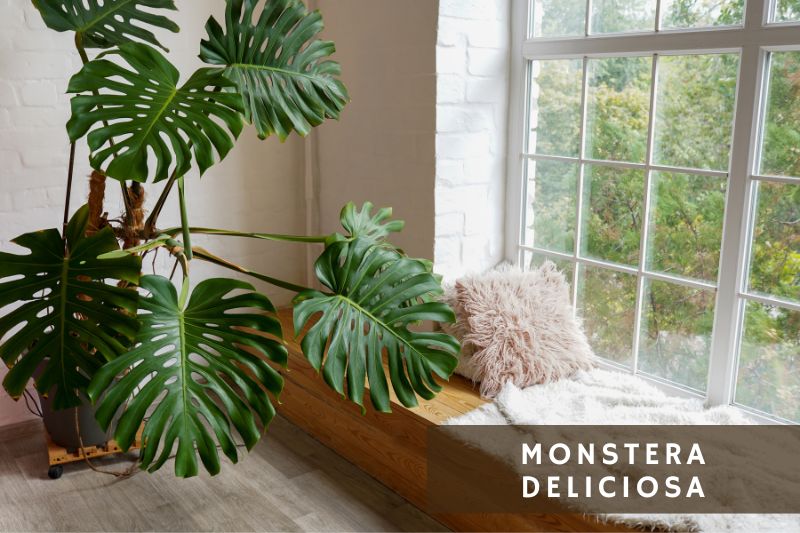
Monstera deliciosa, also known as the Swiss cheese plant, is a popular indoor plant loved for its large, glossy leaves. Native to the tropical rainforests of Central America, this evergreen perennial can grow up to 15 feet tall indoors and thrives in bright, indirect light.
To maintain a healthy Monstera deliciosa, provide support in the form of a moss pole or trellis for its aerial roots and feed with a balanced, water-soluble fertilizer during the growing season. Additionally, keep your Monstera’s leaves dust-free by frequently cleaning them.
3. Weeping Fig (Ficus Benjamina)
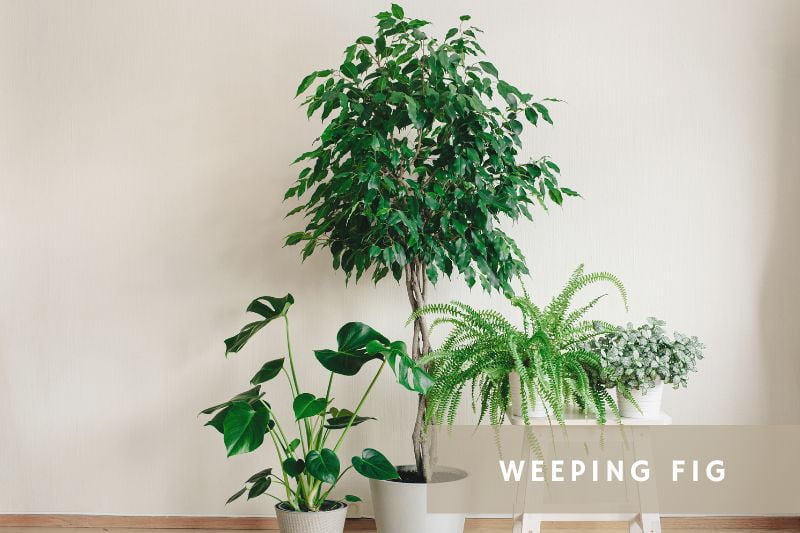
The Weeping fig (Ficus benjamina) is an elegant indoor plant choice, admired for its arching branches and glossy, elliptical leaves. Native to Southeast Asia and Australia, this evergreen tree comes with a moderate growth rate and can reach heights of up to 6 feet indoors.
Requiring minimal care, the Weeping fig thrives in bright, indirect light, and its water and fertilizer needs are relatively low-maintenance. Occasional pruning helps maintain its shape and promotes bushiness.
4. Umbrella Plant (Schefflera Actinophylla)
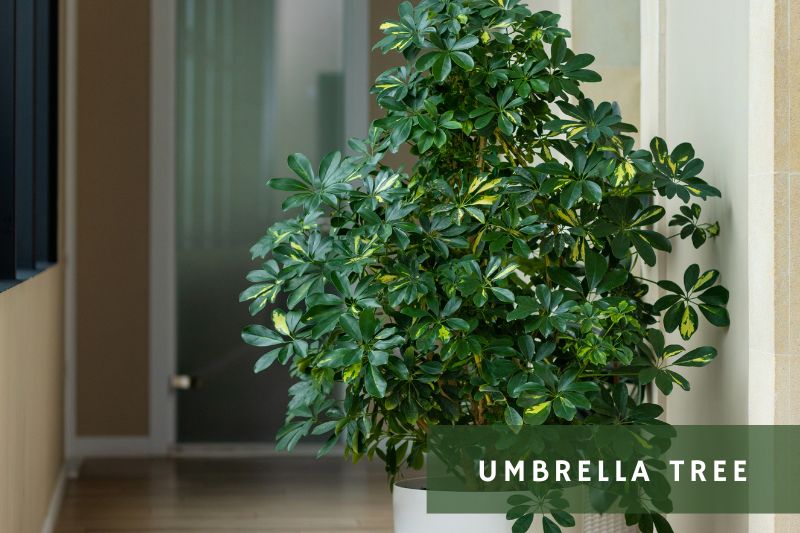
The umbrella tree is another tall indoor plant with a distinctive canopy of glossy, finger-like leaflets that radiate from a central stem. Native to Australia and the Pacific Islands, this evergreen can grow up to 10 feet tall indoors, lending an eye-catching, tropical vibe to your space.
With low-maintenance care requirements, the umbrella tree thrives in bright, indirect light and needs moderate watering.
5. Chinese Hibiscus (Hibiscus rosa-sinensis)

Native to East Asia, Chinese hibiscus (Hibiscus rosa-sinensis) has been admired for centuries for its ornamental value. The name itself derives from its original discovery in China, though it is now widely cultivated in tropical and subtropical regions around the world.
As an indoor plant, Chinese Hibiscus can grow at a moderate rate and reach impressive heights of up to 6 feet or more. Its dark green, glossy leaves create a lush backdrop for the true stars of the show: the spectacular flowers. These blossoms come in a variety of colors such as red, pink, orange, yellow, and even bicolors. Even if they last for a day or two, they bloom in succession, ensuring a continuous display of color throughout the blooming season, which usually lasts from late spring to early fall.
For the Chinese Hibiscus to thrive indoors, it is important to provide it with a well-lit spot, preferably near a south or west-facing window where it can receive ample sunlight.
6. Areca Palm (Dypsis lutescens)

The Areca Palm (Dypsis lutescens) is an elegant indoor plant that comes with a touch of modern sophistication. With its arching, feathery fronds and slender, bamboo-like stems, this tropical beauty will transform your home into a stylish oasis.
Originating from Madagascar, the Areca Palm is well-suited for indoor living, and it can grow up to 8 feet tall, making it an ideal choice for filling vertical space.
7. Bird of Paradise (Strelitzia Reginae)

The Bird of Paradise (Strelitzia reginae) is another tall houseplant that produces flowers (its name actually comes from its crane-like flowers that resemble a bird in flight). Indoors, this architectural plant can reach heights of 4 to 6 feet, with large, fan-like leaves and vibrant blooms that emerge in late winter to early spring.
To flourish, Bird of Paradise needs a brightly-lit spot where it can benefit from a few hours of direct sunlight per day.
8. African Milk Tree (Euphorbia trigona)

As an indoor plant, the African Milk Tree can grow at a steady pace, eventually reaching heights of up to 6-8 feet. Although it does not produce showy flowers like the Chinese Hibiscus, the striking silhouette and low-care nature of the African Milk Tree make it an appealing choice for those who appreciate sculptural plants with minimal fuss.
In terms of care, this tall succulent thrives in bright, indirect light or even partial shade. It’s also drought-tolerant and requires less frequent watering than many other indoor plants.
9. Rubber Fig (Ficus elastica)
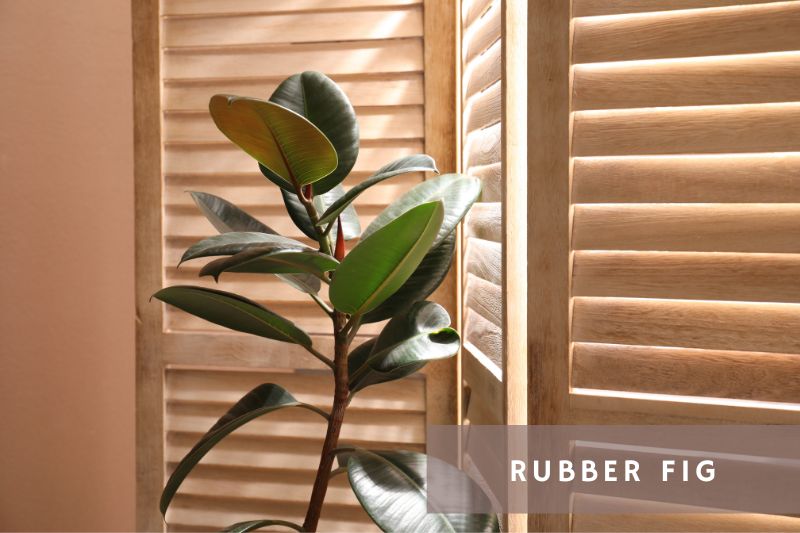
This handsome plant has been a favorite among houseplant enthusiasts for decades due to its air-purifying qualities and ability to adapt to various indoor environments.
Indoors, the Rubber Fig can grow at a moderate pace, with its height reaching anywhere between 6-10 feet, although its growth can be easily controlled with regular pruning.
Caring for a Rubber Fig is relatively straightforward, making it an excellent choice for both novice and experienced plant owners. It thrives in bright, indirect light but can also tolerate lower light levels. Watering should be done when the top inch of the soil has dried out; avoid overwatering, as this can lead to root rot.
10. Corn Plant (Dracaena Fragrans)
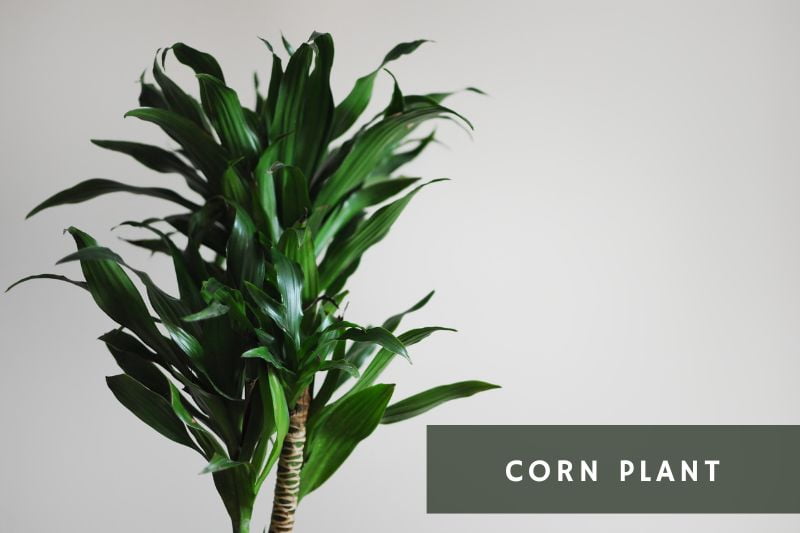
Dracaena fragrans, also known as the Corn Plant, is a popular indoor plant valued for its lush, arching foliage. It originates from tropical Africa and is well-suited for indoor environments.
Indoors, Corn Plants grow slowly, reaching up to 4-6 feet tall. The plant comes with long, sword-like leaves with a creamy-yellow center stripe. Although it rarely flowers indoors, its foliage is lovely enough.
Caring for Dracaena fragrans is also easy. It requires moderate, indirect light and can adapt to lower light conditions. Water when the topsoil is dry, avoiding overwatering. With proper care, Corn Plants become attractive, long-lasting indoor additions.
11. Ponytail Palm (Beaucarnea recurvata)

This fascinating plant is native to Mexico and belongs to the Asparagaceae family, despite its palm-like appearance. With its bulbous base, slender trunk, and long, cascading leaves, the Ponytail Palm offers an eye-catching display that is sure to spark conversation.
The Ponytail Palm is a slow-growing plant that can eventually reach up to 8 feet tall indoors, although it may take many years to achieve this height. Its uniquely swollen base, which stores water, and gracefully arching, ribbon-like leaves create a captivating silhouette, providing a focal point that’s both visually intriguing and low-maintenance.
When it comes to care, the Ponytail Palm thrives in bright, indirect light, although it can tolerate lower light levels as well. Its water-storing base allows it to withstand periods of drought, requiring infrequent watering. To avoid overwatering, allow the top two inches of soil to dry out between waterings.
12. Olive Tree (Olea europaea)
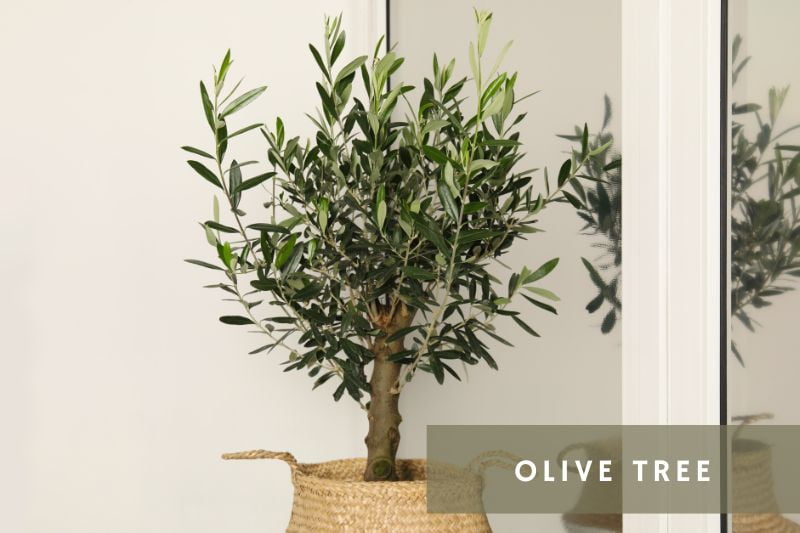
The Olive Tree grows at a slow to moderate pace indoors, but it eventually reaches heights of 6-10 feet, although you can prune it to maintain a smaller size. Its gracefully arching branches and evergreen foliage create a stunning visual presence year-round, offering a sense of elegant, timeless beauty.
While indoor Olive Trees may not produce fruit, their attractive form and storied history make them a compelling choice for those seeking a unique and enduring addition to their indoor plant repertoire.
When it comes to care, the Olive Tree prefers a bright, sunny spot, ideally near a south-facing window where it can receive ample sunlight. This sun-loving plant requires at least 6 hours of direct light daily to thrive.
13. Money Tree (Pachira aquatica)
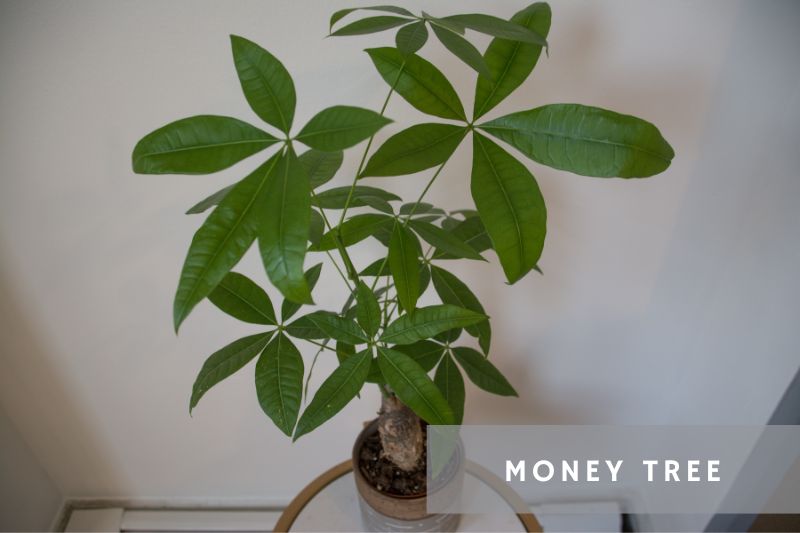
Pachira aquatica, or Money Tree, is a popular indoor plant, native to Central and South America, that adds positive energy to any space. Associated with Feng Shui, its braided trunk and lush, five-lobed leaves create an eye-catching, compact silhouette.
Growing at a moderate pace, indoor Money Trees can reach 6-8 feet but are often pruned to maintain a smaller size. While the plant rarely flowers or produces nuts indoors, its distinctive form and auspicious symbolism make it a popular choice for indoor gardens.
To care for your Money Tree, place it in a bright spot with indirect light and water regularly, allowing the top inch of soil to dry between waterings.
14. Dragon Tree (Dracaena Marginata)
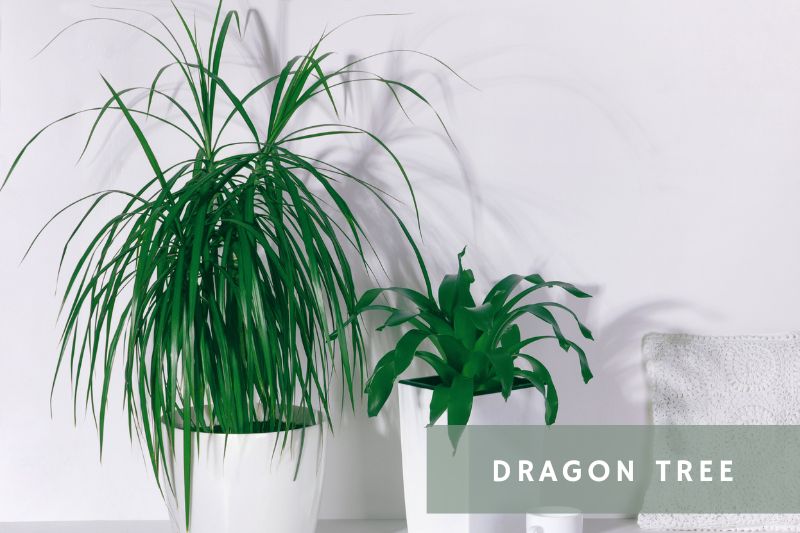
The Dracaena marginata, commonly known as the Dragon Tree, is an impressive indoor plant that also comes with an architectural flair. This striking plant, characterized by its slender, woody stems and elongated, sword-like leaves with red edges, hails from Madagascar.
When grown indoors, the Dragon Tree can reach heights of 6-8 feet but can be easily pruned to maintain your desired size. Its distinctive shape and low-maintenance requirements make it a favorite choice for those seeking a stylish and adaptable addition to their indoor plant collection.
To support you in caring for your Dracaena marginata, we’ve created a detailed care guide that covers all aspects of its maintenance, including lighting and watering needs.
15. Oleander (Nerium oleander)

Oleander, also known as Nerium oleander, is a stunning tall indoor plant that can grow up to 12 feet tall. This evergreen shrub produces long, lance-shaped leaves and clusters of fragrant, colorful flowers that bloom in the summer months. Native to the Mediterranean region, oleanders thrive in warm, dry conditions and require bright, indirect light to grow successfully indoors.
To maintain a healthy oleander plant, ensure it receives well-draining soil and regular fertilization during the growing season. It’s important to note that all parts of the oleander plant are toxic if ingested, so be sure to keep it out of reach of children and pets.
Conclusion
Tall indoor plants like the ones mentioned in this list can truly transform any interior space with their captivating presence and unique features. These plants not only serve as natural air purifiers and mood enhancers but also add a touch of elegance and charm to your home or office.
To create a more dynamic and visually engaging indoor garden, consider complementing these impressive specimens with hanging or trailing plants, as well as large leaf houseplants. By incorporating a diverse mix of plant heights, textures, and growth habits, you can curate a stunning, multi-dimensional green space that invites tranquility and connection with nature, enriching your daily experience and well-being.

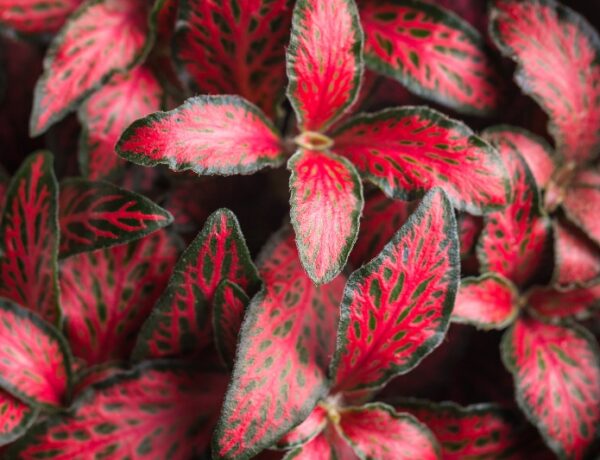
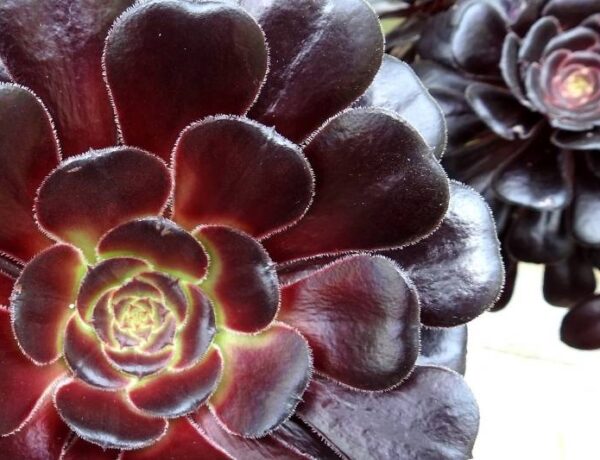



No Comments